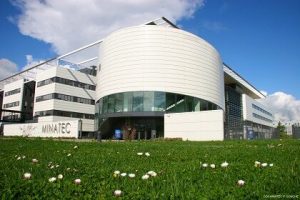Universitat Autònoma de Barcelona
Contact persons:
Montserrat Nafria (montse.nafria@uab.es)
Full Professor
Dept. Enginyeria Electrònica
Escola d’Enginyeria.
Carrer de les Sitges, s/n.
Campus de la UAB · 08193 Bellaterra
Barcelona · Spain
T +34 93 581 18 29
Jordi Sune (jordi.sune@uab.es)
UAB presentation
The group of Micro and Nanoelectronic Devices belongs to the Department of Electronic Engineering of the Universitat Autònoma Barcelona (Spain) and has a large and distinguished experience in the field of nanoelectronic devices, both ultimate CMOS devices (More Moore domain) and also emerging devices that take advantage of materials properties at the nanoscale (Beyond CMOS domain). Its activities cover the device concept, modeling, simulation, characterization and reliability. The group has built the required experimental facilities to carry out this research.
Processing platform
Modelling platform
Parallel Computing Laboratory.
- High performance computing (HPC) cluster, with 32 AMD Opteron 248 processors (single core) and 8 Intel Xeon X5650 CPUs (6-core), with a total of 208 Gb of RAM and 1Tb of user storage, networked through dual Gigabit Ethernet and InfiniBand interconnects.
- VASP 4.6, SIESTA and TRANSIESTA first-principles electronic structure and transport codes
- Other GPLd software for molecular dynamics simulations.
Characterization platform
Nanoscale electrical characterization Laboratory.
- Three atomic force microscopes, equipped with the modules for current (CAFM) and contact potential (KPFM) measurements, temperature and environmental control.
- Prototype of Enhanced-CAFM (ECAFM) with 1pA-1mA current dynamic range, developed by the group.
Device level Electrical Characterization Laboratory.
- 200mm wafer probe stations electro-statically shielded (equipped with thermo-chuck)
- Benches for semiconductor device measurement (Semiconductor Parameter Analyzers, LCR‑meters, switching matrix, pulse generator…).
- Circuit modules for the characterization of highly specific phenomena in electron devices, developed by the group.




 Minatec – CROMA
Minatec – CROMA